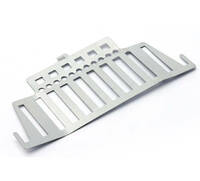Categories
Tags
-
#SEO
#One-Color Closed Ink Cup Pad Printer
#Carbide Ring for Pad Printing Ink Cups
#Motocross Goggles
#At GAIA
#we specialize in the field of flexible packaging
#offering a wide range of innovative and high-quality packaging solutions.
#custom CNC milling services
#Ceramic Lamp Holder
#Wire Electric Motor Automatic Coil Winding Machine
#skiing helmets
#Ground Coffee Bags
#Four Color Pad Printing Machine
#Precision stamping
#Deep drawing
#丝印机
#Ben Wa Balls for Women
#Cantilever Single Twisting Machine
#fashion boxes and bags
#rigid-flex PCBs
#sealed ink cups
#ski goggles
Archives
Deep Drawing: Precision Metal Forming for Hollow and Cylindrica
-
Deep drawing is a specialized sheet metal forming process used to produce deep, hollow, or cylindrical parts from flat metal blanks. It is commonly employed in industries such as automotive, aerospace, appliances, medical devices, and packaging, where parts like cans, sinks, fuel tanks, and cookware are needed. The process offers excellent material utilization and can create seamless parts with high structural integrity.
What Is Deep Drawing?
In deep drawing, a flat metal blank is placed over a die cavity and pressed into shape by a punch. As the punch descends, it forces the material into the die, stretching and compressing it to form a hollow shape. If the depth of the part exceeds its diameter, the process is classified as “deep” drawing.
Multiple stages may be used for complex or very deep parts, including redrawing (reshaping a previously drawn part) and ironing (smoothing wall thickness). The process can be done cold (at room temperature) or hot (for materials that are less ductile).
Key Advantages
-
Seamless Hollow Shapes
Deep drawing produces parts with no seams or welds, enhancing strength, pressure resistance, and visual appeal—ideal for containers and structural components. -
High Material Efficiency
Minimal waste is generated during the process, as most of the original blank is used to form the final part. This improves cost efficiency, especially for high-volume production. -
Excellent Structural Strength
The drawing process naturally work-hardens the material, resulting in stronger, more durable parts without the need for additional strengthening treatments. -
Good Surface Finish
Parts formed through deep drawing generally have smooth, clean surfaces that often require little or no post-processing. -
Scalability
Deep drawing is well-suited for mass production, offering consistent quality, tight tolerances, and repeatability when using precision dies and automated presses.
Materials Used
Materials used for deep drawing must exhibit high ductility and formability. Common choices include:
-
Stainless steel – corrosion resistance and strength
-
Aluminum – lightweight and good thermal conductivity
-
Brass and copper – excellent for decorative and electrical applications
-
Low carbon steel – widely used for automotive and industrial parts
Common Applications
-
Automotive: Fuel tanks, body panels, oil pans, and airbag housings
-
Household appliances: Sinks, cookware, and washing machine drums
-
Packaging: Beverage cans, aerosol containers, and food tins
-
Aerospace and defense: Casings, enclosures, and structural components
-
Medical devices: Surgical instrument housings and implantable device cases
Conclusion
Deep drawing is a versatile and efficient forming process ideal for producing durable, high-quality hollow metal parts. Its ability to create seamless components with excellent strength and surface finish makes it invaluable in a wide range of industries. Whether for mass production or high-precision applications, deep drawing remains a foundational technology in modern manufacturing.
-
